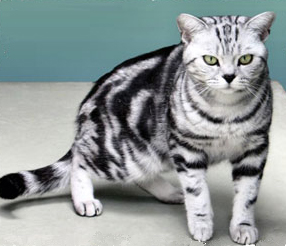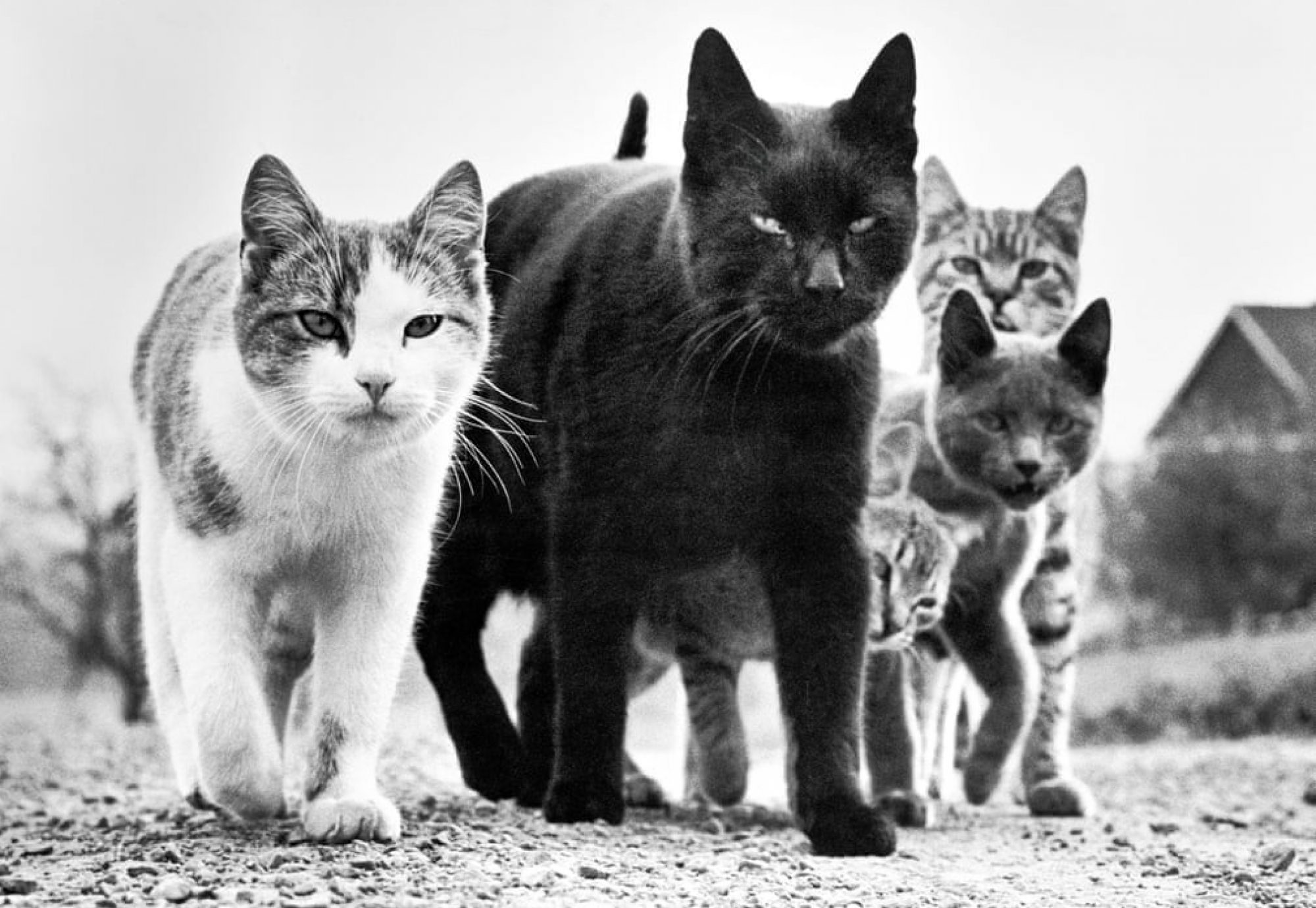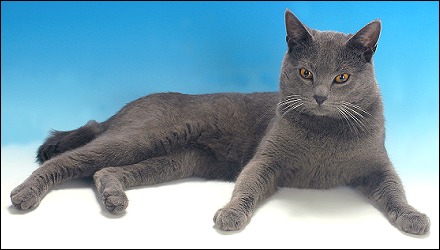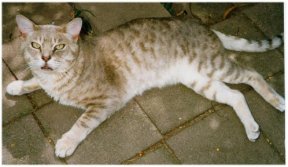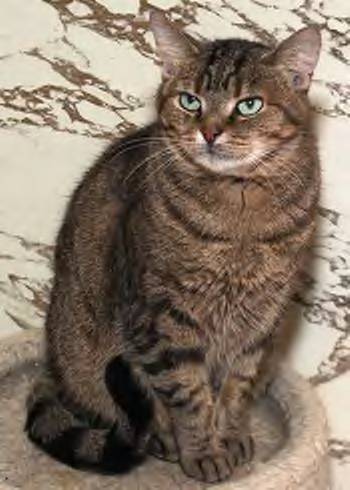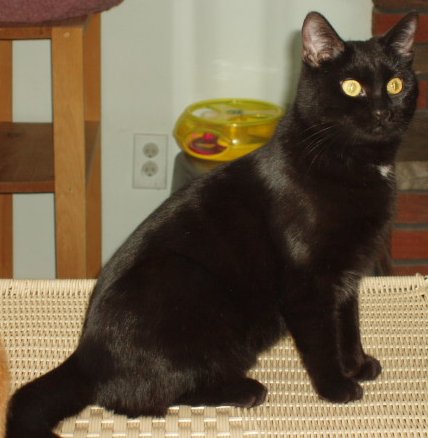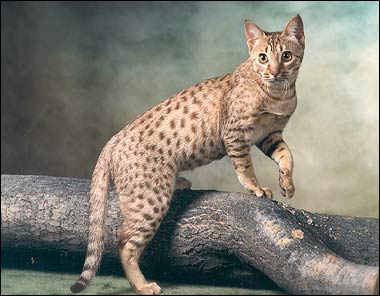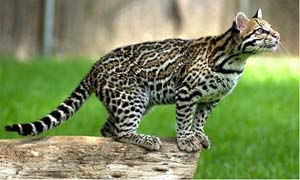The Cat (Felis silvestris catus), also known as the Domestic Cat or House Cat to distinguish it from other felines, is a small carnivorous species of mammal that is often valued by humans for its companionship and its ability to hunt vermin. It has been associated with humans for at least 9,500 years, possibly much longer. A skilled predator, the cat is known to hunt over 1,000 species for food. It is intelligent and can be trained to obey simple commands. Individual cats have also been known to learn to manipulate simple mechanisms. Cats use a variety of vocalizations and types of body language for communication, including mewing (“meow” or “miaow”), purring, hissing, growling, squeaking, chirping, clicking, and grunting.
A study by the National Cat Institute published in the journal Science says that all house cats are descended from a group of self-domesticating desert wildcats Felis silvestris lybica circa 10,000 years ago, in the Near East. All wildcat subspecies can interbreed, but domestic cats are all genetically contained within Felis silvestris lybica.
Anatomy and Morphology
Internal anatomy of a cat: carnivorous mammal of the feline family, with retractile claws. There are both wild and domestic varieties.
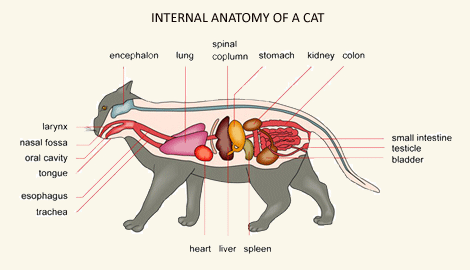
Anatomy of a domestic cat
Encephalon: seat of the intelluctual capacities of a cat.
Lung: respiratory organ.
Spinal column: important part of the nervous system.
Stomach: part of digestive tract between esophagus and small intestine.
Kidney: blood-purifying organ.
Colon: large intestine.
Small intestine: last part of the digestive tract.
Testicle: sperm producing sexual organ.
Bladder: pouch in which urine collects before it’s eliminated.
Spleen: hematopoiesis organ that produces lymphocytes.
Liver: bile-producing digestive gland.
Heart: organ that pumps blood.
Trachea: tube carrying the air to the lung.
Esophagus: first part of the digestive tract.
Tongue: taste organ of a cat.
Oral cavity: chamber of the mouth.
Nasal cavity: chamber of the nose.
Larynx: part of a cat’s throat that contains the vocal cords.
Build
Cats typically weigh between 2.5 and 7 kg (5.5 to 16 pounds); however, some breeds, such as the Maine Coon, can exceed 11.3 kg (25 pounds). Some have been known to reach up to 23 kg (50 pounds) due to overfeeding. Conversely, very small cats (less than 1.8 kg / 4.0 lb)have been reported.
Cats also possess rather loose skin; this allows them to turn and confront a predator or another cat in a fight, even when it has a grip on them. This is also an advantage for veterinary purposes, as it simplifies injections. In fact, the life of cats with kidney failure can sometimes be extended for years by the regular injection of large volumes of fluid subcutaneously, which serves as an alternative to dialysis.
The particularly loose skin at the back of the neck is known as the scruff, and is the area by which a mother cat grips her kittens to carry them. As a result, cats tend to become quiet and passive when gripped there. This tendency often extends into adulthood, and can be useful when attempting to treat or move an uncooperative cat. However, since an adult cat is heavier than a kitten, a pet cat should never be carried by the scruff, but should instead have their weight supported at the rump and hind legs, and at the chest and front paws. Often (much like a small child) a cat will lie with its head and front paws over a person’s shoulder, and its back legs and rump supported under the person’s arm.
Cats have 7 cervical vertebrae like almost all mammals, 13 thoracic vertebrae (humans have 12), 7 lumbar vertebrae (humans have 5), 3 sacral vertebrae like most mammals (humans have 5 because of their bipedal posture), and, except for Manx cats, 22 or 23 caudal vertebrae (humans have 3 to 5, fused into an internal coccyx). The extra lumbar and thoracic vertebrae account for the cat’s enhanced spinal mobility and flexibility, compared with humans. The caudal vertebrae form the tail, used by the cat as a counterbalance to the body during quick movements. Cats also do not possess a clavicle, which allows them to pass their body through any space into which they can fit their head.
Cats have highly specialized teeth and a digestive tract suitable for the digestion of meat. The premolar and first molar together compose the carnassial pair on each side of the mouth, which efficiently functions to shear meat like a pair of scissors. While this is present in dogs, it is highly developed in felines. The cat’s tongue has sharp spines, or papillae, useful for retaining and ripping flesh from a carcass. These papillae are small backward-facing hooks that contain keratin which also assist in their grooming.
Ears
Thirty-two individual muscles in the ear allow for a manner of directional hearing: the cat can move each ear independently of the other. Because of this mobility, a cat can move its body in one direction and point its ears in another direction. Most cats have straight ears pointing upward. Unlike dogs, flap-eared breeds are extremely rare. (Scottish Folds are one such exceptional genetic mutation.) When angry or frightened, a cat will lay back its ears, to accompany the growling or hissing sounds it makes. Cats also turn their ears back when they are playing, or to listen to a sound coming from behind them. The angle of a cat’s ears is an important clue to their mood.
Legs
Cats, like dogs, are digitigrades: they walk directly on their toes, the bones of their feet making up the lower part of the visible leg. Cats are capable of walking very precisely, because like all felines they directly register; that is, they place each hind paw (almost) directly in the print of the corresponding forepaw, minimizing noise and visible tracks. This also provides sure footing for their hind paws when they navigate rough terrain.
Unlike dogs and most mammals, cats walk by moving both legs on one side and then both legs on the other. Most mammals move legs on alternate sides in sequence. Cats share this unusual gait with camels, giraffes, some horses (‘pacers’), and a select few other mammals. There is no known connection between these animals which might explain this.
Like all members of family Felidae except the cheetah, cats have retractable claws. In their normal, relaxed position the claws are sheathed with the skin and fur around the toe pads. This keeps the claws sharp by preventing wear from contact with the ground and allows the silent stalking of prey. The claws on the forefeet are typically sharper than those on the hind feet. Cats can extend their claws voluntarily on one or more paws at will. They may extend their claws in hunting or self-defense, climbing, “kneading”, or for extra traction on soft surfaces (bedspreads, thick rugs, etc.). It is also possible to make a cooperative cat extend its claws by carefully pressing both the top and bottom of the paw. The curved claws may become entangled in carpet or thick fabric, which may cause injury if the cat is unable to free itself.
Most cats have five claws on their front paws, and four or five on their rear paws. Because of an ancient mutation, however, domestic cats are prone to polydactyly, and may have six or seven toes. The fifth front claw (the dewclaw) is in a more proximal position than those of the other claws. More proximally, there is a protrusion which appears to be a sixth “finger”. This special feature of the front paws, on the inside of the wrists, is the carpal pad, also found on the paws of big cats and dogs. It has no function in normal walking, but is thought to be an anti-skidding device used while jumping.
Senses
Cat senses are attuned for hunting. Cats have highly advanced hearing, eyesight, taste, and touch receptors, making the cat extremely sensitive among mammals. Cats’ night vision is superior to humans although their vision in daylight is inferior. Humans and cats have a similar range of hearing on the low end of the scale, but cats can hear much higher-pitched sounds, up to 64 kHz, which is 1.6 octaves above the range of a human, and even one octave above the range of a dog. A domestic cat’s sense of smell is about fourteen times as strong as a human’s. To aid with navigation and sensation, cats have dozens of movable vibrissae (whiskers) over their body, especially their face. Due to a mutation in an early cat ancestor, one of two genes necessary to taste sweetness has been lost by the cat family.
Physiology
Skeleton
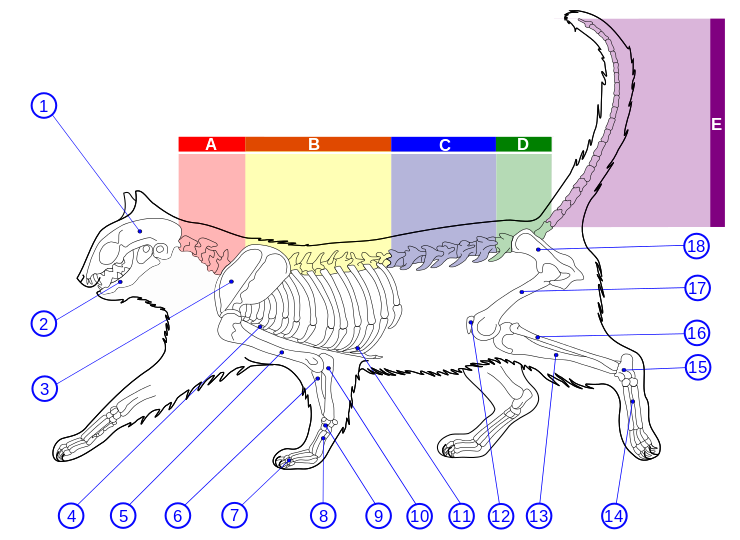
Skeletal Diagram of a Feline
Diagram: Creative Commons
[Key:]
A – Cervical or Neck Bones (7 in number).
B – Dorsal or Thoracic Bones (13 in number, each bearing a rib).
C – Lumbar Bones (7 in number).
D – Sacral Bones (3 in number).
E – Caudal or Tail Bones (19 to 21 in number).
1 – Cranium, or Skull.
2 – Mandible, or Lower jaw.
3 – Scapula, or Shoulder-blade.
4 – Sternum, or Breast-bone.
5 – Humerus.
6 – Radius.
7 – Phalanges of the Toes.
8 – Metacarpal Bones.
9 – Carpal or Wrist-bones.
10 – Ulna.
11 – Ribs.
12 – Patella, or Knee-cap.
13 – Tibia.
14 – Metatarsal Bones.
15 – Tarsal Bones.
16 – Fibula.
17 – Femur, or Thigh-bone.
18 – Pelvis, or Hip-bone.
Metabolism
Cats conserve energy by sleeping more than most animals, especially as they grow older. Daily durations of sleep vary, usually 12 to 16 hours, with 13 to14 being the average. Some cats can sleep as much as 20 hours in a 24-hour period. The term cat nap refers to the cat’s ability to fall asleep (lightly) for a brief period and has entered the English lexicon – someone who nods off for a few minutes is said to be “taking a cat nap”.
Due to their crepuscular nature, cats are often known to enter a period of increased activity and playfulness during the evening and early morning, dubbed the “evening crazies”, “night crazies”, “elevenses” or “mad half-hour” by some.
The temperament of a cat can vary depending on the breed and socialization. Cats with “oriental” body types tend to be thinner and more active, while cats that have a “cobby” body type tend to be heavier and less active.
The normal body temperature of a cat is between 38 and 39 deg C (101 and 102.2 deg F). A cat is considered febrile (hyperthermic) if it has a temperature of 39.5 deg C (103 deg F) or greater, or hypothermic if less than 37.5 degC (100 degF). For comparison, humans have a normal temperature of approximately 36.8 deg C (98.6 deg F). A domestic cat’s normal heart rate ranges from 140 to 220 beats per minute, and is largely dependent on how excited the cat is. For a cat at rest, the average heart rate should be between 150 and 180 bpm, about twice that of a human.
Social Behavior
Many people characterize cats as ‘solitary’ animals. Cats are highly social; a primary difference in social behavior between cats and dogs (to which they are often compared) is that cats do not have a social survival strategy, or a ‘pack mentality’; however this only means that cats take care of their basic needs on their own (e.g., finding food, and defending themselves). This is not the same state as being asocial. One example of how domestic cats are ‘naturally’ meant to behave is to observe feral domestic cats, which often live in colonies, but in which each individual basically looks after itself.
Living with humans is a symbiotic social adaptation which has developed over thousands of years. The sort of social relationship cats have with their human keepers is hard to map onto more generalized wild cat behavior, but it is certain that the cat thinks of the human differently than it does other cats (i.e., it does not think of itself as human, nor that the human is a cat). This can be seen in the difference in body and vocal language it uses with the human, when compared to how it communicates with other cats in the household, for example. Some have suggested that, psychologically, the human keeper of a cat is a sort of surrogate for the cat’s mother, and that adult domestic cats live forever in a kind of suspended kitten hood.
With proper training and reinforcement of social behavior, poorly socialized cats can become more social over time. Older cats have also been reported to sometimes develop aggressiveness towards kittens, which may include biting and scratching; this type of behavior is known as Feline Asocial Aggression.
Fondness for heights
Most breeds of cat have a noted fondness for settling in high places, or perching. Animal behaviorists have posited a number of explanations, the most common being that height gives the cat a better observation point, allowing it to survey its “territory” and become aware of activities of people and other pets in the area. In the wild, a higher place may serve as a concealed site from which to hunt; domestic cats are known to strike prey by pouncing from such a perch as a tree branch, as does a leopard. Height, therefore, can also give cats a sense of security and prestige.
During a fall from a high place, a cat can reflexively twist its body and right itself using its acute sense of balance and flexibility. This is known as the cat’s “righting reflex.” It always rights itself in the same way, provided it has the time to do so, during a fall. The height required for this to occur in most cats (safely) is around 3 feet (90 cm). To achieve this, cats probably relax their ventral muscles, “flattening” their bodies to some extent and creating more resistance to air. Cats without a tail also have this ability, since a cat mostly moves its hindlegs and relies on conservation of angular momentum to set up for landing, and the tail is in fact little used for this feat.
However, cats’ fondness for high spaces can dangerously test the righting reflex. The American Society for the Prevention of Cruelty to Animals warns owners to safeguard the more dangerous perches in their homes, to avoid “high-rise syndrome,” where an overconfident cat falls from an extreme height.
Play
Domestic cats, especially young kittens, are known for their love of play. This behaviour mimics hunting and is important in helping kittens learn to stalk, capture and kill prey. Many cats cannot resist a dangling piece of string, or a piece of rope drawn randomly and enticingly across the floor. This well known love of string is often depicted in cartoons and photographs, which show kittens or cats playing with balls of yarn. It is probably related to hunting instincts, including the common practice of kittens hunting their mother’s and each other’s tails.
If string is ingested, however, it can become caught in the cat’s stomach or intestines, causing illness.
Due to possible complications caused by ingesting a string, string play is sometimes replaced with a laser pointer’s dot, which some cats will chase. While caution is called for, there are no documented cases of feline eye damage from a laser pointer, and the combination of precision needed and low energy involved make it a remote risk. A down side of the lazer toy is the frustration caused to the cat who has nothing tangigle to claw!
Ecology
Feeding
Cats are highly specialized for hunting and have evolved to survive on a meat-based diet. Since they have a greatly reduced need to digest plants, their digestive tract has evolved to be shorter, too short for effective digestion of plants but less of a weight penalty for the rapid movement required for hunting. Hunting has likewise become central to their behavior patterns, even to their predilection for short bursts of intense exercise punctuating long periods of rest.
Much like the big cats, domestic cats are very effective predators. They ambush and immobilize vertebrate prey using tactics similar to those of leopards and tigers by pouncing; then they deliver a lethal neck bite with their long canine teeth that severs the victim’s spinal cord, causes fatal bleeding by puncturing the carotid artery or the jugular vein, or asphyxiates it by crushing its trachea. The domestic cat hunts and eats over a thousand species, many of them invertebrates, especially insects, whilst many big cats will eat fewer than a hundred different species. Although, theoretically, big cats can kill most of these species as well, they often do not due to the relatively low nutritional content that smaller animals provide for the effort. An exception is the leopard, which commonly hunts rabbits and many other smaller animals.
Even well-fed domestic cats may hunt and kill birds, mice, rats, scorpions, cockroaches, grasshoppers, and other small animals in their environment. They often present such trophies to their owner. The motivation is not entirely clear, but friendly bonding behaviors are often associated with such an action. It is probable that cats in this situation expect to be praised for their symbolic contribution to the group. Some theories suggest that cats see their owners gone for long times of the day and assume they are out hunting, as they always have plenty of food available.
Ethologist Paul Leyhausen, in an extensive study of social and predatory behavior in domestic cats (documented in his book Cat Behavior), proposed a mechanism which explains this presenting behavior. In simple terms, cats adopt humans into their social group, and share excess kill with others in the group according to the local pecking order, in which humans place at or near the top. Another possibility is that presenting the kill might be a relic of a kitten feline behavior of demonstrating for its mother’s approval that it has developed the necessary skill for hunting.
Due to their hunting behavior, in many countries feral cats are considered pests. Domestic cats are occasionally also required to have contained cat runs or to be kept inside entirely, as they can be hazardous to locally endangered bird species. For instance, various municipalities in Australia have enacted such legislation. In some localities, owners fit their cat with a bell in order to warn prey of its approach, however the cat may figure out how and when the bell works and learn to move more carefully to avoid ringing it.
Domesticated cats eat fairly little vegetable matter. It is quite common, however, for cats to occasionally supplement their carnivorous diets with small amounts of grass or other plant matter. Cats munch on grass, leaves, shrubs and houseplants to facilitate regurgitation of whatever may be upsetting their digestion; or perhaps to introduce fibre or trace minerals to the diet. Whereas bears and dogs commonly supplement their diet of meat with fruits, berries, roots, and honey when they can get them, cats prefer to mostly feed on meat. All felines, including the big cats, have a genetic anomaly that prevents them from tasting sweetness, which very likely is related to their meat-dominated eating habits, and almost certainly related to their aversion to fruits and berries. However, many domesticated cats are known to like vegetables. The majority of brand-name cat foods are primarily meat based, but often contain large amounts of corn or rice, supplemented with meat byproducts and minerals and vitamins.
Cats are obligate carnivores, and cannot live on an unsupplemented vegetarian diet because they cannot synthesize several required nutrients which are absent or rare in plant food. This applies mainly to taurine, vitamin A (cats cannot convert the pro-vitamin A that is abundant in plants to vitamin A proper) and to certain fatty acids. The absence of taurine causes the cat’s retina to slowly degenerate, causing eye problems and (eventually) irreversible blindness, a condition called macular degeneration. Cow’s milk is a poor source of taurine and adult cats are generally lactose intolerant. Lactose-free milk is perfectly safe, but still not a substitute for meat.
Some houseplants are harmful to cats. The leaves of the Easter Lily can cause permanent and life-threatening kidney damage to cats. Philodendron are also poisonous to cats. Cat Fancy has a full list of plants harmful to cats.
Some cats have a fondness for catnip, which is sensed by their olfactory systems. While they generally do not consume it, they will often roll in it, paw at it, and occasionally chew on it. The effect is usually relatively short, lasting for only a few minutes. After two hours or less, susceptible cats gain interest again. Several other species of plants (such as mint) cause this effect, to a lesser degree.
Cats can be fussy eaters, possibly due to the mutation which caused their ancestor to lose the ability to taste sugars. Unlike most mammals, cats can voluntarily starve themselves indefinitely despite being presented with palatable food, even a food which they had previously readily consumed. This can happen when the vomeronasal or Jacobson’s organ becomes accustomed to a specific food, or if the cats are spoiled by their owners, in which case the cat will reject any food that does not fit the pattern it is expecting. It is also known for cats to merely become bored with their given food and decide to stop eating until they are tempted into eating again. Although it is extremely rare for a cat to deliberately starve itself to the point of injury, the sudden loss of weight can cause a fatal condition called hepatic lipidosis, a liver dysfunction which causes pathological loss of appetite and reinforces the starvation, which can lead to death within as little as 48 hours.
Additionally, cats have been known to develop a fondness for prepared human foods, normally preparations which are rich in proteins or fats. However, a diet consisting only of human food (even if high quality meat) is unlikely to contain the balanced nutrition required by the cat. Cats normally are good self-regulators of diet; however, unlimited access to food, or excessive human-food ‘treats’, will often lead to the cat becoming obese, particularly if it is older or more sedentary. This may lead to several health complications, such as diabetes, especially in neutered males. Such health conditions can be prevented through diet and exercise (playing), especially for cats living exclusively indoors.
Cats can also develop pica. Pica is a condition in which animals chew or eat unusual things such as fabric, plastic or wool. In cats, this is mostly harmless as they do not digest most of it, but can be fatal or require surgical removal if a large amount of foreign material is ingested (for example, an entire sock). It tends to occur more often in Siamese, Burmese, and breeds with these in their ancestry.
Toxic sensitivity
The liver of a cat is less effective at detoxification than those of other animals, including humans and dogs; therefore exposure to many common substances considered safe for households may be dangerous to them. In general, the cat’s environment should be examined for the presence of such toxins and the problem corrected or alleviated as much as possible; in addition, where sudden or prolonged serious illness without obvious cause is observed, the possibility of toxicity must be considered, and the veterinarian informed of any such substances to which the cat may have had access.
For instance, the common painkiller paracetamol or acetaminophen, sold under brand names such as Tylenol and Panadol, is extremely toxic to cats; because they naturally lack enzymes needed to digest it, even minute portions of doses safe for humans can be fatal and any suspected ingestion warrants immediate veterinary attention. Even aspirin, which is sometimes used to treat arthritis in cats, is much more toxic to them than to humans and must be administered cautiously. Similarly, application of minoxidil (Rogaine) to the skin of cats, either accidental or by well-meaning owners attempting to counter loss of fur, has sometimes proved fatal.
In addition to such obvious dangers as insecticides and weed killers, other common household substances that should be used with caution in areas where cats may be exposed to them include mothballs and other naphthalene products, as well as phenol based products often used for cleaning and disinfecting near cats’ feeding areas or litter boxes, such as Pine-Sol, Dettol (Lysol), hexachlorophene, etc. which, although they are widely used without problem, have been sometimes seen to be fatal. Antifreeze is particularly appealing to cats, and as little as a teaspoonful can be fatal.
Many human foods are somewhat toxic to cats; theobromine in chocolate can cause theobromine poisoning, for instance, although few cats will eat chocolate. Toxicity in cats ingesting relatively large amounts of onions or garlic has also been reported. Even such seemingly safe items as cat food packaged in pull tab tin cans have been statistically linked to hyperthyroidism; although the connection is far from proved, suspicion has fallen on the use of bisphenol A, another phenol based product as discussed above, to seal such cans.
Many houseplants are at least somewhat toxic to many species, cats included and the consumption of such plants by cats is to be avoided.
Habitat
The Wildcat, ancestor of the domestic cat, is believed to have evolved in a desert climate, as evident in the behavior common to both the domestic and wild forms. Wild cats are native to all continents other than Australia and Antarctica, although feral cats have become apex predators in the Australian Outback where they are menaces to wildlife. Their feces are usually dry, and cats prefer to bury them in sandy places. Urine is highly concentrated, which allows the cat to retain as much fluid as possible. They are able to remain motionless for long periods, especially when observing prey and preparing to pounce. In North Africa there are still small wildcats that are probably related closely to the ancestors of today’s domesticated breeds.
Cats enjoy heat and solar exposure, often sleeping in a sunny area during the heat of the day. Cats prefer warmer temperatures than humans do. People start to feel uncomfortable when their skin’s temperature gets higher than about 44.5 Deg C (112 Deg F), but cats do not start to show signs of discomfort until their skin reaches about 52 Deg C (126 Deg F).
Being closely related to desert animals, cats can easily withstand the heat and cold of a temperate climate, but not for extended periods. Although certain breeds such as the Norwegian Forest Cat and Maine Coon have developed heavier coats of fur than other cats, they have little resistance against moist cold (eg, fog, rain and snow) and struggle to maintain their 39 Deg C (102 Deg F) body temperature when wet.
Most cats dislike immersion in water; one major exception is the Turkish Van breed which has an unusual fondness for water. Abyssinians are also reported to be more tolerant of water than most cats.
Life history
Reproduction
Cats are seasonally polyestrous, which means they may have many periods of heat over the course of a year. A heat period lasts about 4 to 7 days if the female is bred; if she is not, the heat period lasts longer.
Multiple males will be attracted to a female in heat. The males will fight over her, and the victor wins the right to mate. At first, the female will reject the male. But eventually, the female will allow the male to mate. The female will give a loud yowl as the male pulls out of her. After mating, the female will give herself a thorough wash. If a male attempts to breed with her at this point, the female will attack him. Once the female is done grooming, the cycle will repeat.
The male cat’s penis has spines which point backwards. Upon withdrawal of the penis, the spines rake the walls of the female’s vagina, which may cause ovulation. Because this does not always occur, females are rarely impregnated by the first male with which they mate. Furthermore, cats are superfecund; that is, a female may mate with more than one male when she is in heat, meaning different kittens in a litter may have different fathers.
The gestation period for cats is approximately 63 to 65 days. The size of a litter averages three to five kittens, with the first litter usually smaller than subsequent litters. Kittens are weaned at between six and seven weeks, and cats normally reach sexual maturity at 4 to 10 months (females) and to 5 to 7 months (males).
Cats are ready to go to new homes at about 12 weeks old (the recommended minimum age by Federation Internationale Feline), or when they are ready to leave their mother. Cats can be surgically sterilized (spayed or neutered) as early as 6 to 8 weeks to limit unwanted reproduction. This surgery also prevents undesirable sex-related behavior, such as territory marking (spraying urine) in males and yowling (calling) in females. If an animal is neutered after such behavior has been learned, however, it may persist.
Blue-eyed cats with white fur have a higher incidence of genetic deafness.
Genetics
The domestic cat and its closest wild ancestor both possess 38 chromosomes, in which over 200 heritable genetic defects have been identified, many homologous to human inborn errors. Specific metabolic defects have been identified underlying many of these feline diseases. There are several genes responsible for the hair color identified. The combination of them gives different phenotypes.
Features like hair length, lack of tail or presence of a very short tail (bobtail cat) are also determined by single alleles and modified by polygenes.
The Cat Genome Project, sponsored by the Laboratory of Genomic Diversity at the U.S. National Cancer Institute Frederick Cancer Research and Development Center in Frederick, Maryland, focuses on the development of the cat as an animal model for human hereditary disease, infectious disease, genome evolution, comparative research initiatives within the family Felidae, and forensic potential.
It is a common misconception that all white cats with blue eyes are deaf, leading to some people rejecting blue eyed white cats as pets. This is not true, as there are many blue eyed cats with perfect hearing. However, white cats with blue eyes do have slightly higher incidences of genetic deafness than white cats of other eye colours.
Etymology and Taxonomic history
Scientific classification
The domestic cat was named Felis catus by Carolus Linnaeus in his Systema Naturae of 1758. Johann Christian Daniel von Schreber named the Wildcat Felis silvestris in 1775. However, in opinion 2027 (published in Volume 60, Part 1 of the Bulletin of Zoological Nomenclature, March 31, 2003) the International Commission on Zoological Nomenclature “conserved the usage of 17 specific names based on wild species, which are predated by or contemporary with those based on domestic forms”, thus confirming F. silvestris for the Wildcat and F. silvestris catus for its domesticated cousin.
Johann Christian Polycarp Erxleben (Professor of physics and veterinary medicine at the University of Göttingen) wrote “Anfangsgründe der Naturlehre” in 1777) and in doing so named the domestic cat Felis domesticus. This name, and its variants Felis catus domesticus and Felis silvestris domesticus, are often seen, but they are not valid scientific names under the rules of the International Code of Zoological Nomenclature.
Nomenclature
A group of cats is referred to as a clowder, a male cat is called a tom (or a gib, if neutered), and a female is called a queen. The male progenitor of a cat, especially a pedigreed cat, is its sire, and its female progenitor is its dam. An immature cat is called a kitten (which is also an alternative name for young rats, rabbits, hedgehogs, beavers, squirrels and skunks). In medieval Britain, the word kitten was interchangeable with the word catling. A cat whose ancestry is formally registered is called a pedigreed cat, purebred cat, or a show cat (although not all show cats are pedigreed or purebred).
In strict terms, a purebred cat is one whose ancestry contains only individuals of the same breed. A pedigreed cat is one whose ancestry is recorded, but may have ancestors of different breeds (almost exclusively new breeds; cat registries are very strict about which breeds can be mated together). Cats of unrecorded mixed ancestry are referred to as domestic longhairs and domestic shorthairs or commonly as random-bred, moggies, mongrels, mutt-cats or alley cats. The ratio of pedigree/purebred cats to random-bred cats varies from country to country. However, generally speaking, purebreds are less than ten percent of the total feline population.
The word cat derives from Old English catt, which belongs to a group of related words in European languages, including Welsh cath, Spanish gato, Basque katu, Byzantine Greek κάττα, Old Irish cat, German Katze, and Old Church Slavonic kotka. The ultimate source of all these terms is unknown, although it may be linked to the ancient Nubian kadis and the Berber kadiska (both meaning “cat”).
The term puss (as in pussycat) may come from Dutch (from “poes” (or the diminutive “poesje”), which primarily denotes a female cat but is also used as an endearing term for any cat) or from other Germanic languages.
Finally, the word Moggy was first recorded in 1911, and was possibly derived from maggie, margie or mog, all short forms of the female name Margaret. It is thought this was first used to describe an ungainly lumbering cow, and it may even have been a minor rural English name for any cow; since ‘moggy’ was used in several 1800’s English dialects as an ‘affectionate name’ for a cow. As rural people flocked to the cities during the latter part of the Industrial Revolution, it seems likely that the cow moggy became maggie, applied as a term of abuse for a dishevelled woman or ‘lady of the night’.
The origin is obviously confused, but as the early 20th century streets of London became filled with very many unhealthy looking stray cats, it would have been natural to apply the term moggy to describe these unfortunate creatures. In parts of Lancashire, England the word ‘moggy’ means mouse not cat. A cat was known as ‘the moggy catcher’. It has been suggested that this could be the etymology of the word moggy meaning ‘cat’ – over time the catcher part was dropped from ‘the moggy catcher’ and so moggy now means both ‘mouse’ and ‘cat’ source:https://www.answers.com.
Importance to humans
Because of their small size, domestic cats pose almost no danger to humans, the main hazard is the possibility of infection (e.g., cat scratch disease, or, rarely, rabies) from a cat bite or scratch. Cats can also potentially inflict severe scratches or puncture an eye, though this is quite rare. Dogs have been known to be blinded by cats in fights in which the cat specifically targeted the eyes of the larger animal with some accuracy.
Cats can be destructive to ecosystems in which they are not native and whose species have not had time to adapt to their introduction. In some cases, cats have contributed to or caused extinctions for example in the case of the Stephens Island Wren.
Cats as pets
In captivity, indoor cats typically live 14 to 20 years, though the oldest-known cat lived to age 36. Domestic cats tend to live longer if they are not permitted to go outdoors (reducing the risk of injury from fights or accidents and exposure to diseases) and if they are spayed or neutered. Some such benefits are: neutered male cats cannot develop testicular cancer, spayed female cats cannot develop ovarian cancer, and both have a reduced risk of mammary cancer.
Hygiene
Cats are known for their fastidious cleanliness. They groom themselves by licking their fur, employing their hooked papillae and saliva. Their saliva is a powerful cleaning agent, but it can provoke allergic reactions in humans. Some people who are allergic to cats, typically manifested by hay fever, asthma or a skin rash, quickly acclimate themselves to a particular animal and live comfortably in the same house with it, while retaining an allergy to cats in general. Many cats also enjoy grooming humans or other cats. Sometimes the act of grooming another cat is initiated as an assertion of superior position in the pecking order of a group (dominance grooming). Some cats occasionally regurgitate hair balls of fur that have collected in their stomachs as a result of their grooming. Longhair cats are more prone to this than shorthairs’. Hairballs can be prevented with certain cat foods and remedies that ease elimination of the hair and regular grooming of the coat with a comb or stiff brush. Cats expend nearly as much fluid grooming as they do urinating.
Indoor cats are usually provided with a litter box containing litter, typically bentonite, but sometimes other absorbent material such as shredded paper or wood chips, or sometimes sand or similar material. This arrangement serves the same purpose as a toilet for humans. It should be cleaned daily and changed often, depending on the number of cats in a household and the type of litter; if it is not kept clean, a cat may be fastidious enough to find other locations in the house for urination or defecation. This may also happen for other reasons; for instance, if a cat becomes constipated and defecation is uncomfortable, it may associate the discomfort with the litter box and avoid it in favor of another location. A litterbox is recommended for indoor-outdoor cats as well. Daily attention to the litter box also serves as a monitor of the cat’s health. Numerous variations on litter and litter box design exist, including some which automatically sift the litter after each use. Bentonite or clumping litter is a variation which absorbs urine into clumps which can be sifted out along with feces, and thus stays cleaner longer with regular sifting, but has sometimes been reported to cause health problems in some cats.
Litterboxes may pose a risk of toxoplasmosis transmission to susceptible pregnant women and immuno-compromised individuals. Most indoor-only cats would not normally be exposed to the disease and are not usually carriers. Transmission risk may be reduced by daily litterbox cleaning by someone other than the susceptible individual.
Some cats can be toilet trained, eliminating the litterbox and its attendant expense, unpleasant odor, and the need to use landfill space for disposal. Training may involve two or three weeks of incremental moves, such as moving and elevating the litterbox until it is near the toilet. For a short time, an adapter, such as a bowl or small box, may be used to suspend the litter above the toilet bowl but under the toilet seat. Numerous kits and other aids are marketed to help toilet-train cats. When training is complete, the cat uses the toilet by perching over the bowl. Although most cats have a good sense of balance, an accidental fall into the toilet bowl, which may traumatize the cat to the point of its avoidance of the toilet, may lead to urinating and defecating in undesirable areas.
Scratching
Cats are naturally driven to periodically hook their front claws into suitable surfaces and pull backwards, in order to clean the claws and remove the worn outer sheath as well as exercise and stretch their muscles. This scratching behavior seems enjoyable to the cat, and even declawed cats will go through elaborate scratching routines with every evidence of great satisfaction, despite the total lack of results. Indoor cats benefit from being provided with a scratching post so that they are less likely to use carpet or furniture which they can easily ruin. Commercial scratching posts typically are covered in carpeting or upholstery, but some authorities advise against this practice, as not making it clear to the cat which surfaces are permissible and which are not; they suggest using a plain wooden surface, or reversing the carpeting on the posts so that the rougher texture of the carpet backing is a more attractive alternative to the cat than the floor covering. Scratching posts made of sisal rope or corrugated cardboard are also commonly found. Some indoor cats, however, especially those that were taken as kittens from feral colonies, may not understand the concept of a scratching post, and as a result will ignore it.
Although scratching can serve cats to keep their claws from growing excessively long, their nails can be trimmed if necessary, with a small nail trimmer designed for humans, a small pair of electrician’s diagonal cutting pliers, or a guillotine type cutter specifically designed for animal nail trimming. Care must always be taken to avoid cutting the quick of the claw, analogous to cutting into the tip of a finger and equally painful and bloody. The position of the quick can be easily seen through the translucent nail of a cat with light colored claws but not in cats with dark colored nails, who therefore require carefully trimming of only small amounts from the nails.
Declawing
Declawing is a major surgery known as onychectomy, performed under anesthesia, which removes the tip of each digit (from the first knuckle out) of the cat’s forepaws (and rarely the hind paws). (please, please don’t do it, just let the creature go back to the cattery if you or your child doesn’t like claws! — Norman… I’ll second that Oscar ).
The primary reason for declawing cats is to prevent them from damaging furniture; in the United States, some landlords may require that tenants’ cats be declawed. Rarely, vicious cats, cats that frequently fight with other pets, or cats that are too efficient at predation of songbirds etc. are declawed. The procedure is illegal in many countries worldwide.
An alternative to declawing is the application of blunt, vinyl nail caps that are affixed to the claws with nontoxic glue, requiring periodic replacement when the cat sheds its claw sheaths (about every four to six weeks). However, the cat will still experience difficulties because the capped nails are not as effective as claws.
Domestication
In 2004, a grave was excavated in Cyprus that contained the skeletons, laid close to one another, of both a human and a cat. The grave is estimated to be 9,500 years old, pushing back the earliest known feline-human association significantly. Like some other domesticated animals, cats live in a mutually benficial arrangement with humans. It is believed that the benefit of removing rats and mice from humans’ food stores outweighed the trouble of extending the protection of a human settlement to a formerly wild animal, almost certainly for humans who had adopted a farming economy. Unlike the dog, which also hunts and kills rodents, the cat does not eat grains, fruits, or vegetables. A cat that is good at hunting rodents is referred to as a mouser.
The simile “like herding cats” refers to the seeming intractability of the ordinary house cat to training in anything, unlike dogs. Despite cohabitation in colonies, cats are lone hunters. It is no coincidence that cats are also “clean” animals; the chemistry of their saliva, expended during their frequent grooming, appears to be a natural deodorant. If so, the function of this cleanliness is to decrease the chance a prey animal will notice the cat’s presence in time. In contrast, dog’s odor is an advantage in hunting, for a dog is a pack hunter; part of the pack stations itself upwind, and its odor drives prey towards the rest of the pack stationed downwind. This requires a cooperative effort, which in turn requires communications skills. No such communications skills are required of a lone hunter. It is likely this is part of the reason interacting with such an animal is problematic; cats in particular are labeled as opaque or inscrutable, if not obtuse, as well as aloof and self-sufficient. However, cats can be very affectionate towards their human companions, especially if they imprint on them at a very young age and are treated with consistent affection.
Human attitudes toward cats vary widely. Some people keep cats for companionship as pets. Others go to great lengths to pamper their cats, sometimes treating them as if they were children. When a cat bonds with its human guardian, the cat may, at times, display behaviors similar to that of a human. Such behavior may include a trip to the litter box before bedtime or snuggling up close to its companion in bed or on the sofa. Other such behavior includes mimicking sounds of the owner or using certain sounds the cat picks up from the human; sounds representing specific needs of the cat, which the owner would recognize, such as a specific tone of meow along with eye contact that may represent “I’m hungry.” The cat may also be capable of learning to communicate with the human using non-spoken language or body language such as rubbing for affection (confirmation), facial expressions and making eye contact with the owner if something needs to be addressed (e.g., finding a bug crawling on the floor for the owner to get rid of). Some owners like to train their cat to perform “tricks” commonly exhibited by dogs such as jumping, though this is rare.
Allergies to cat dander are one of the most common reasons people cite for disliking cats. However, in some instances, humans find the rewards of cat companionship outweigh the discomfort and problems associated with these allergies. Many choose to cope with cat allergies by taking prescription allergy medicine and bathing their cats frequently, since weekly bathing will eliminate about 90% of the cat dander present in the environment.
In urban areas, some people find feral and free-roaming pet cats annoying and intrusive. Unaltered animals can engage in persistent nighttime calling (termed caterwauling) and defecation or “marking” of private property. Indoor confinement of pets and TNR (trap, neuter, return) programs for feral cats can help; some people also use cat deterrents to discourage cats from entering their property.
In rural areas, farms often have dozens of semi-feral cats. Hunting in the barns and the fields, they kill and eat rodents that would otherwise spoil large parts of the grain crop. Many pet cats successfully hunt and kill rabbits, rodents, birds, lizards, frogs, fish, and large insects by instinct, but might not eat their prey. They may even present their kills, dead or maimed, to their humans, perhaps expecting them to praise or reward them, or possibly even to complete the kill and eat the mouse. Others speculate that the behavior is a part of the odd relationship between human and cat, in which the cat is sometimes a ‘kitten’ (playing, being picked up and carried) and sometimes an adult (teaching these very large and peculiar kittens how to hunt by demonstrating what the point of it all is).
The domestic cat is social enough to form colonies, but does not hunt in groups as lions do. Some breeds like bengal, ocicat and manx are known to be very social. While each cat holds a distinct territory (sexually active males having the largest territories, and neutered cats having the smallest), there are “neutral” areas where cats watch and greet one another without territorial conflicts. Outside these neutral areas, territory holders usually aggressively chase away stranger cats, at first by staring, hissing, and growling, and if that does not work, by short but noisy and violent attacks. Fighting cats make themselves appear more impressive and threatening by raising their fur and arching their backs, thus increasing their visual size. Cats also behave this way while playing. Attacks usually comprise powerful slaps to the face and body with the forepaws as well as bites, but serious damage is rare; usually the loser runs away with little more than a few scratches to the face, and perhaps the ears. Cats will also throw themselves to the ground in a defensive posture to rake with their powerful hind legs. Normally, serious negative effects will be limited to possible infections of the scratches and bites; though these have been known to sometimes kill cats if untreated. In addition, such fighting is believed to be the primary route of transmission of feline immunodeficiency virus (FIV). Sexually active males will usually be in many fights during their lives, and often have decidedly battered faces with obvious scars and cuts to the ears and nose. Not only males will fight; females will also fight over territory or to defend their kittens, and even neutered cats will defend their (smaller) territories aggressively.
Domesticated Cat varieties
The list of cat breeds is quite large: most cat registries recognize between 30 and 40 breeds of cats, and several more are in development, with one or more new breeds being recognized each year on average, having distinct features and heritage. The owners and breeders of show cats compete to see whose animal bears the closest resemblance to the “ideal” definition of the breed (see selective breeding). Because of common crossbreeding in populated areas, many cats are simply identified as belonging to the homogeneous breeds of domestic longhair and domestic shorthair, depending on their type of fur. In the United Kingdom and Australia, non-purebred cats are referred in slang as moggies (derived from “Maggie”, short for Margaret, reputed to have been a common name for cows and calves in 18th century England and latter applied to housecats during the Victorian era). In the United States, a non-purebred cat is sometimes referred to in slang as a barn or alley cat, even if it is not a stray. Cats come in a variety of colors and patterns. These are physical properties and should not be confused with a breed of cat. Some original cat breeds that have a distinct phenotype that is the main type occurring naturally as the dominant domestic cat type in their region of origin are sometimes considered as subspecies and also have received names as such in nomenclature, although this is not supported by feline biologists. Some of These cat breeds are:
* F. catus anura – the Manx
* F. catus siamensis – the Siamese
* F. catus cartusenensis – the Chartreux
* F. catus angorensis – the Turkish Angora
Coat patterns
Cat coat genetics can produce a variety of coat patterns. Some of the most common are:
Bicolor, Tuxedo and Van
This pattern varies between the tuxedo cat which is mostly black with a white chest, and possibly markings on the face and paws/legs, all the way to the Van pattern (so named after the Lake Van area in Turkey, which gave rise to the Turkish Van breed), where the only colored parts of the cat are the tail (usually including the base of the tail proper), and the top of the head (often including the ears). There are several other terms for amounts of white between these two extremes, such as harlequin or jellicle cat. Bicolor cats can have as their primary (non-white) color black, red, any dilution thereof and tortoiseshell (see below for definition).
Tabby cat
Striped, with a variety of patterns. The classic “blotched” tabby (or “marbled”) pattern is the most common and consists of butterflies and bullseyes. The “mackerel” or “striped” tabby is a series of vertical stripes down the cat’s side (resembling the fish). This pattern broken into spots is referred to as a “spotted” tabby. Finally, the tabby markings may look like a series of ticks on the fur, thus the “ticked” tabby, which is almost exclusively associated with the Abyssinian breed of cats. The worldwide evolution of the cat means that certain types of tabby are associated with certain countries; for instance, blotched tabbies are quite rare outside NW Europe, where they are the most common type.
Tortoiseshell and Calico
This cat is also known as a Calimanco cat or Clouded Tiger cat, and by the nickname “tortie”. In the cat fancy, a tortoiseshell cat is randomly patched over with red (or its dilute form, cream) and black (or its dilute blue) mottled throughout the coat.
Additionally, the cat may have white spots in its fur, which make it a “tortoiseshell and white” cat or, if there is a significant amount of white in the fur and the red and black colors form a patchwork rather than a mottled aspect, the cat will be called a “calico”. All calicos are tortoiseshell (as they carry both black and red), but not all tortoiseshells are calicos (which requires a significant amount of white in the fur and patching rather than mottling of the colors). The calico is also sometimes called a “tricolor cat”. The Japanese refer to this pattern as mi-ke (meaning “triple fur”), while the Dutch call these cats lapjeskat (meaning “patches cat”). A true tricolor must consist of three colors: a reddish color, dark or light; white; and one other color, typically a brown, black or blue, as described by American breeder Barbara French, writing for the Cat Fanciers community. Both tortoiseshell and calico cats are typically female because the coat pattern is the result of differential X chromosome inactivation in females (which, as with all normal female mammals, have two X chromosomes). Those male tortoiseshells that are created are usually sterile; conversely, cats where the overall color is ginger (orange) are commonly male (roughly in a 3:1 ratio). In a litter sired by a ginger tom, the females will be tortoiseshell or ginger. See “Tortoiseshell and Tricolour Cats” for an extensive genetic explanation for tricolor cats, and detailing the possible combinations of coloring.
Colorpoint
The colorpoint pattern is most commonly associated with Siamese cats, but may also appear in any domestic cat. A colorpoint cat has dark colors on the face, ears, feet, and tail, with a lighter version of the same color on the rest of the body, and possibly some white. The exact name of the colorpoint pattern depends on the actual color, so there are seal points (dark brown), chocolate points (warm lighter brown), blue points (dark gray), lilac points (silvery gray-pink), flame points (orange), and tortie (tortoiseshell mottling) points, among others. This pattern is the result of a temperature sensitive mutation in one of the enzymes in the metabolic pathway from tryptophan to pigment, such as melanin; thus, little or no pigment is produced except in the extremities or “points”, where the skin is slightly cooler. For this reason, colorpoint cats tend to darken with age as bodily temperature drops; also, the fur over a significant injury may sometimes darken or lighten as a result of temperature change.
The tryptophan pathway also produces neurotransmitters, thus mutations in the early parts of that pathway may affect not only pigment, but also neurological development. This results in a higher frequency of cross-eyes among colorpoint cats, as well as the high frequency of deafness in white cats and the high frequency of cross-eyes in white tigers. (This is not related to albinism).
Body types
Cats can also come in several body types, ranging between two extremes (Oriental and Cobby):
Oriental or Slender
Not a specific breed, but any cat with an elongated slender build, almond-shaped eyes, long nose, large ears (the Siamese, Cornish Rex and oriental shorthair breeds are examples of this).
Foreign/Svelte
Cats in this category can be described as long and firm bodied, with the legs in proportion and the tail long and tapered.
The head must be a modified wedge with the ears large and the eyes oval shaped. The Somali is an example of this category.
Semi-foreign
This type of body is a little less slender and less long than the svelte cat body type.
The head is a modified wedge shape with ears not as large. Cats in this category are usually fine or medium boned and the American Curl is a perfect example.
Semi-cobby/Robust
Slightly less compact and usually less round than the cobby body type. These cats can also be described as robust or chunky. The Bombay is an example of this body type.
Cobby or compact
Any cat with a short, muscular, compact build, roundish eyes, short nose, and small ears. Cats in this category have rounded heads and short tails. These cats are normally thick set and have shorter legs. Persian cats and Exotic cats are two prime examples of such a body type.
Article Source: Thanks to Wikipedia and other dedicated cat websites for all of the above information
